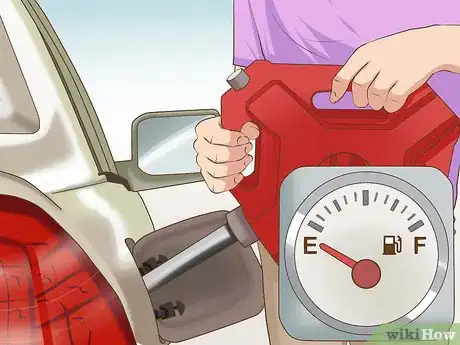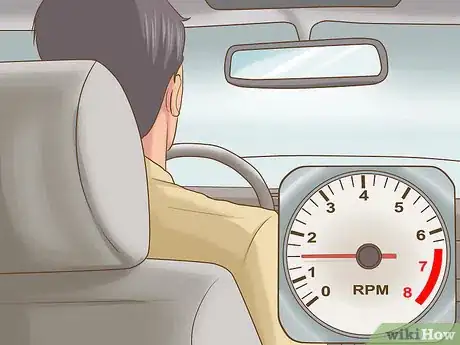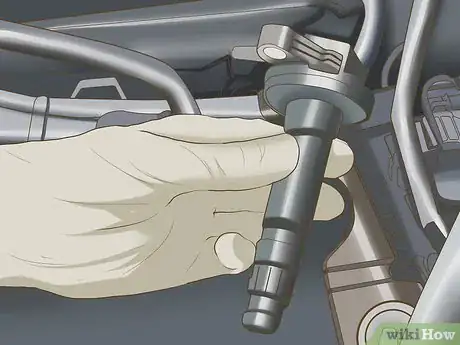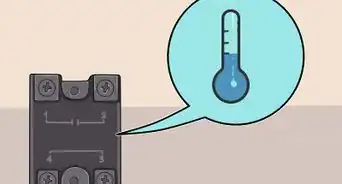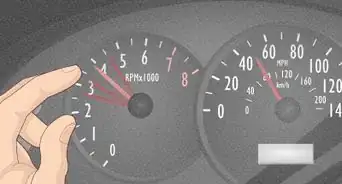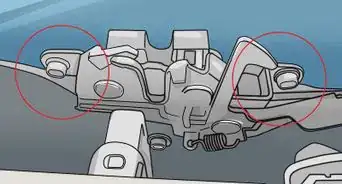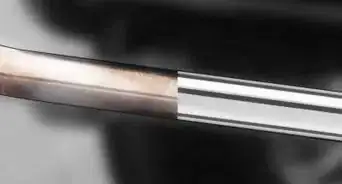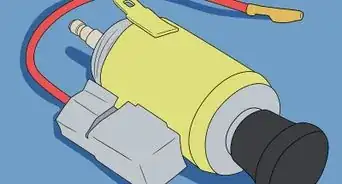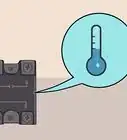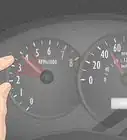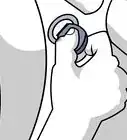This article was co-authored by Duston Maynes. Duston Maynes is an Automotive Repair Specialist at RepairSmith. Duston specializes in leading a team that handles a variety of automotive repairs including replacing spark plugs, front and rear brake pads, fuel pumps, car batteries, alternators, timing belts, and starter motors. Duston holds an Associate’s degree in Automotive/Diesel Technology from The Universal Technical Institute of Arizona and is a Certified Diagnostic Technician and Automobile Mechanics Technician through BMW STEP. RepairSmith received The 2020 Big Innovation Award by Business Intelligence Group and The Startup of the Year by the American Business Awards. RepairSmith was also included in Built in LA’s 50 Startups to Watch and The Business Intelligence Group’s 52 Names Leading the Way in Customer Service. RepairSmith offers in-home services to provide car owners convenient and complete auto repair everywhere.
There are 9 references cited in this article, which can be found at the bottom of the page.
wikiHow marks an article as reader-approved once it receives enough positive feedback. In this case, 88% of readers who voted found the article helpful, earning it our reader-approved status.
This article has been viewed 782,121 times.
If you find that your car won’t start, there are a number of issues that may be the culprit. The three primary categories that you should address first are the starter and battery, fuel delivery, and ignition. Chances are that if your vehicle won’t start, the problem lies somewhere within that short list. Start narrowing down possible issues in order to determine what you need to do in order to repair the vehicle.
Steps
Checking the Starter and Battery
-
1Listen the vehicle when you try to start it. The easiest issue with starting your vehicle to diagnose is often a dead battery. When you turn the key in the ignition, listen to the sound the motor makes as it attempts to start. If it doesn’t make any sound at all, it may simply be a dead battery.[1]
- If you can hear clicking, it may be because the starter is attempting to work but does not have enough power.
- If the engine is turning over but won’t start, it likely isn’t an issue with the battery.
-
2Check the battery terminals. Open the hood of the vehicle and look over the connections from the battery to the engine. There are two terminals (positive and negative) and both must have clean metal on metal connections in order to transmit electricity sufficiently.[2] Check to ensure both cables are connected and that the terminals aren’t covered in debris or oxidization.[3]
- Use a steel tooth brush to clean corroded battery terminals.
- Ensure the cables are tight on the terminals and cannot be wiggled or pulled off the battery.
Advertisement -
3Test the battery. Once you’ve checked the battery cables, use a voltmeter to test the voltage in the battery. Turn on the voltmeter and touch the positive (red) lead to the positive terminal on the battery, then touch the negative lead to the negative terminal.[4] If the battery is fully charged, it should read between 12.4 and 12.7 volts.[5]
- If the battery is dead, try jump starting it.
- If the battery won’t hold a charge, replace it and try starting the vehicle again.
-
4Attempt to jump start the vehicle. If the cables on the battery are secure, use another vehicle to jump start the engine. Connect the two batteries using jumper cables, making sure to use the red cable on the positive terminals and the black cable on the negative terminals.[6]
- Be sure to connect the positive to the positive and negative to the negative terminals, otherwise you may do serious damage to the vehicle.[7]
- Some engines have a main fuse just after the battery that will pop if you accidentally switch the cables. You will need to purchase a replacement fuse if you break it.
-
5Test the starter solenoid. If jump starting the car didn’t work, there may be an issue with the starter or solenoid. Start by testing the starter solenoid using a test light. Touch the test light to the bottom terminal on the solenoid and ground the negative cable on the body of the vehicle. Have a friend attempt to start the vehicle to see if the solenoid engages.[8]
- If the solenoid does not engage, it has gone bad and will need to be replaced.
Ensuring the Engine is Getting Fuel
-
1Add fuel if the vehicle’s out of gas. If the vehicle is extremely low on fuel or out of gas, add some using a red plastic gas container designed to carry and pour gas into a vehicle’s fuel tank. Gasoline eats through many kinds of plastic, so it is very important you use a container intended to transport it. Screw the nozzle onto the large opening on the can, then open the breather cap on the other side before pouring the gas into your vehicle.[9]
- The breather cap allows air to travel into the can, permitting the gas to pour out into the vehicle’s fuel tank.
- Be careful not to spill gasoline on yourself or the paint.
-
2Look for signs of jerking as you drive before it dies. A common sign of trouble with your vehicle’s fuel system is jerking or inconsistent power while you are driving at a consistent speed, such as on the highway. If you begin to feel the engine delivering intermittent power despite your foot staying in the same place on the throttle, it may be because of an issue with fuel delivery.[10]
- If the RPMs also drop with the engine’s power delivery, that indicates a fuel problem.
- If the RPMs climb as the power fails to reach the wheels, that is usually a transmission problem instead.
-
3Check to see if the vehicle will start again after a few minutes. If the engine stalls as you are driving and struggles to start or run again immediately after, try letting it sit for a few minutes and trying again. If the engine starts up and runs properly after sitting for twenty minutes or so, it could be due to a clogged fuel filter.[11]
- As sediment builds up in a fuel filter, it can block the passage of fuel into the engine.
- Once the filter sits for a few minutes, the sediment may settle, allowing fuel to pass through once again.
-
4Replace your fuel filter. Your vehicle may not be getting fuel because the fuel filter is completely clogged. Replace your fuel filter by locating it beneath the vehicle and disconnecting the fuel lines going in and out of it. Remove the filter from the bracket and install a new one to allow fuel to flow to the engine once again.[12]
- You can purchase replacement fuel filters at your local auto parts store.
- A severely clogged fuel filter can lead to burning out your fuel pump.
-
5Test your fuel pump. There are a few methods you can use to test your fuel pump to see if it is functioning properly. Be sure to check that it is receiving electrical current, then you may want to do a flow test to check the volume of fuel it is sending to the engine.[13]
- If the fuel pump is not functioning properly, it will need to be replaced.
- Refer to the service manual for your specific vehicle for instructions on replacing the fuel pump.
Testing the Ignition System
-
1Check your spark plugs for signs of damage. Use a spark plug socket to remove the spark plugs in your engine and look them over to diagnose problems that may exist. Remove each plug and inspect them for specific types of damage that may indicate what’s keeping the engine from starting.[14]
- Tan or grey metal plugs are in good working order.
- Black or burnt plugs indicate that there is too much fuel going into the engine.
- Blisters or boiling on the plug indicates that the engine was severely overheated.
-
2Replace spark plugs if need be. If the spark plugs appear to be fouled out, you will need to address the issue that caused them to foul in order to make the engine run properly. Once done, replace the damaged spark plugs with new ones.[15]
- Make sure to gap new spark plugs properly for your application.
- You can find the appropriate gap to put into the plug in the service manual for your vehicle.
-
3Check the plug wires. Ensure each of the spark plug wires is securely fastened to the spark plug and to the ignition coil. You can also use an ohm meter to conduct a spark plug resistance test to ensure the plug wires are transmitting sufficient electricity to the spark plugs to ignite the air and fuel mixture within the engine.[16]
- Look for signs of damage such as fraying or cracks in the spark plug wires.
- Replace any damaged spark plug wires even if they are not what’s keeping the engine from starting.
-
4Test the ignition coils. Although unlikely, if all of your ignition coils fail to function it will prevent the engine from starting. Test your ignition coils by removing a spark plug and connecting it again to its plug wire. Touch the metal from the plug to a piece of metal in the engine bay and have a friend turn the key in the ignition.[17]
- If the coil is functioning properly, you will see a blue spark come from the plug.
- Test each ignition coil in your engine.
Expert Q&A
-
QuestionWhy won't my car start when the battery is good?
 Duston MaynesDuston Maynes is an Automotive Repair Specialist at RepairSmith. Duston specializes in leading a team that handles a variety of automotive repairs including replacing spark plugs, front and rear brake pads, fuel pumps, car batteries, alternators, timing belts, and starter motors. Duston holds an Associate’s degree in Automotive/Diesel Technology from The Universal Technical Institute of Arizona and is a Certified Diagnostic Technician and Automobile Mechanics Technician through BMW STEP. RepairSmith received The 2020 Big Innovation Award by Business Intelligence Group and The Startup of the Year by the American Business Awards. RepairSmith was also included in Built in LA’s 50 Startups to Watch and The Business Intelligence Group’s 52 Names Leading the Way in Customer Service. RepairSmith offers in-home services to provide car owners convenient and complete auto repair everywhere.
Duston MaynesDuston Maynes is an Automotive Repair Specialist at RepairSmith. Duston specializes in leading a team that handles a variety of automotive repairs including replacing spark plugs, front and rear brake pads, fuel pumps, car batteries, alternators, timing belts, and starter motors. Duston holds an Associate’s degree in Automotive/Diesel Technology from The Universal Technical Institute of Arizona and is a Certified Diagnostic Technician and Automobile Mechanics Technician through BMW STEP. RepairSmith received The 2020 Big Innovation Award by Business Intelligence Group and The Startup of the Year by the American Business Awards. RepairSmith was also included in Built in LA’s 50 Startups to Watch and The Business Intelligence Group’s 52 Names Leading the Way in Customer Service. RepairSmith offers in-home services to provide car owners convenient and complete auto repair everywhere.
Automotive Repair Specialist If you got a new battery and it died after a while, that can be an indication of a parasitic draw. This happens when a module on your vehicle gets a wrong signal or a wire is touching something, leaving part of the system on and causing a drop in the battery. All you got to do is pinpoint where the draw is coming from.
If you got a new battery and it died after a while, that can be an indication of a parasitic draw. This happens when a module on your vehicle gets a wrong signal or a wire is touching something, leaving part of the system on and causing a drop in the battery. All you got to do is pinpoint where the draw is coming from. -
QuestionHow do you diagnose a car not starting?
 Duston MaynesDuston Maynes is an Automotive Repair Specialist at RepairSmith. Duston specializes in leading a team that handles a variety of automotive repairs including replacing spark plugs, front and rear brake pads, fuel pumps, car batteries, alternators, timing belts, and starter motors. Duston holds an Associate’s degree in Automotive/Diesel Technology from The Universal Technical Institute of Arizona and is a Certified Diagnostic Technician and Automobile Mechanics Technician through BMW STEP. RepairSmith received The 2020 Big Innovation Award by Business Intelligence Group and The Startup of the Year by the American Business Awards. RepairSmith was also included in Built in LA’s 50 Startups to Watch and The Business Intelligence Group’s 52 Names Leading the Way in Customer Service. RepairSmith offers in-home services to provide car owners convenient and complete auto repair everywhere.
Duston MaynesDuston Maynes is an Automotive Repair Specialist at RepairSmith. Duston specializes in leading a team that handles a variety of automotive repairs including replacing spark plugs, front and rear brake pads, fuel pumps, car batteries, alternators, timing belts, and starter motors. Duston holds an Associate’s degree in Automotive/Diesel Technology from The Universal Technical Institute of Arizona and is a Certified Diagnostic Technician and Automobile Mechanics Technician through BMW STEP. RepairSmith received The 2020 Big Innovation Award by Business Intelligence Group and The Startup of the Year by the American Business Awards. RepairSmith was also included in Built in LA’s 50 Startups to Watch and The Business Intelligence Group’s 52 Names Leading the Way in Customer Service. RepairSmith offers in-home services to provide car owners convenient and complete auto repair everywhere.
Automotive Repair Specialist You're probably better off taking the vehicle to a shop to look it over. Trying to diagnose the problem yourself is going to be more difficult, since you'll need special equipment and a pretty good understanding of electronics and energy flow.
You're probably better off taking the vehicle to a shop to look it over. Trying to diagnose the problem yourself is going to be more difficult, since you'll need special equipment and a pretty good understanding of electronics and energy flow. -
QuestionWhen I try to start my key it will not turn in the ignition. It seems liked it is locked in place. How do I fix it?
 Community AnswerThis is probably due to the steering wheel lock. Apply pressure to the key as you turn the steering wheel away from the lock. As the steering wheel unlocks, the ignition cylinder will as well.
Community AnswerThis is probably due to the steering wheel lock. Apply pressure to the key as you turn the steering wheel away from the lock. As the steering wheel unlocks, the ignition cylinder will as well.
References
- ↑ http://www.popularmechanics.com/cars/how-to/a5837/how-to-replace-a-cars-starter-motor/
- ↑ Duston Maynes. Automotive Repair Specialist. Expert Interview. 14 July 2021.
- ↑ http://www.popularmechanics.com/cars/how-to/a5837/how-to-replace-a-cars-starter-motor
- ↑ Duston Maynes. Automotive Repair Specialist. Expert Interview. 14 July 2021.
- ↑ https://www.2carpros.com/articles/car-battery-dead-overnight
- ↑ http://www.popularmechanics.com/cars/how-to/a5837/how-to-replace-a-cars-starter-motor/
- ↑ Duston Maynes. Automotive Repair Specialist. Expert Interview. 14 July 2021.
- ↑ http://www.popularmechanics.com/cars/how-to/a5837/how-to-replace-a-cars-starter-motor/
- ↑ https://www.youtube.com/watch?v=nytxlA-G1Sk
- ↑ https://electorstrust.org/signs-of-a-bad-fuel-pump//
- ↑ https://electorstrust.org/signs-of-a-bad-fuel-pump/
- ↑ http://www.aa1car.com/library/fuel_pump_diagnose.htm
- ↑ http://www.aa1car.com/library/fuel_pump_diagnose.htm
- ↑ https://www.2carpros.com/articles/how-to-test-an-ignition-system
- ↑ https://www.2carpros.com/articles/how-to-test-an-ignition-system
- ↑ https://www.2carpros.com/articles/how-to-test-an-ignition-system
- ↑ https://www.2carpros.com/articles/how-to-test-an-ignition-system
About This Article
To fix a car that doesn't start, you'll first need to diagnose the issue. Start by checking the battery to confirm that the cables are connected and free of debris or oxidization, then use a voltmeter to check the battery's voltage. If the battery is fine, take a look at fuel-related functions. Replace your fuel filter if it looks dirty, and test the fuel pump by performing a flow test to make sure the engine is receiving fuel. You will need to replace the fuel pump if it's the culprit. For tips on testing the starter and ignition system, read on!






